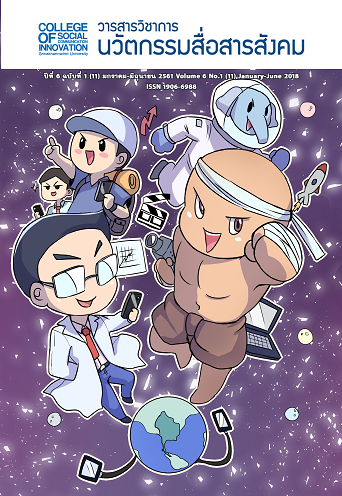การประยุกต์ใช้หลักธรรมในชีวิตประจำวันจากทศชาติชาดก: กรณีศึกษาจากเรียงความของนักเรียนชั้นประถมศึกษาปีที่ 6 โรงเรียนในสังกัดกรุงเทพมหานคร*
(The Apply of Dhamma Principle in Daily Lives from Dasajataka: Case Studies on Reports of Sixth Grade Students in Bangkok Metropolitan Administration)
คำสำคัญ:
การประยุกต์, การประยุกต์ใช้หลักธรรม, ทศชาติชาดก, Application, Dhamma Application, Dasajatakaบทคัดย่อ
บทคัดย่อ
บทความวิจัยนี้มีจุดมุ่งหมายเพื่อศึกษาความรู้ ความเข้าใจ และการประยุกต์ใช้หลักธรรมจากทศชาติชาดกของเด็กวัยเด็กตอนกลาง รวมทั้งปัจจัยที่ทำให้เด็กเข้าใจหลักธรรมจากทศชาติชาดกเพื่อแสดงให้เห็นว่าทศชาติชาดกมีความสำคัญในฐานะเครื่องมือปลูกฝังจริยธรรมของเด็กไทย ผู้วิจัยเก็บข้อมูลโดยจัดประกวดเขียนเรียงความของนักเรียนประถมศึกษาปีที่ 6 โรงเรียนในสังกัดกรุงเทพมหานคร เพื่อเป็นตัวบทในการวิเคราะห์และสัมภาษณ์เพิ่มเติมเพื่อศึกษาการประยุกต์ใช้หลักธรรม
ผลการวิจัยพบว่านักเรียนระดับประถมศึกษาปีที่ 6 มีความรู้และความเข้าใจหลักธรรมในทศชาติชาดก โดยสามารถเล่าเนื้อเรื่อง บอกชื่อตัวละคร บอกพฤติกรรมของพระโพธิสัตว์ในทศชาติชาดก อธิบายหลักธรรมและขยายความความหมายของหลักธรรม นักเรียนเลือกเขียนเรียงความเกี่ยวกับมหาชนกชาดกมากที่สุด รองลงมาคือเวสสันดรชาดก และสุวรรณสามชาดก ส่วนมโหสถชาดก วิธุรชาดก ภูริทัตชาดก จันทกุมารชาดก นารทพรหมชาดก เตมียชาดก และเนมิราชชาดกเลือกเขียนเรียงลำดับตามมา โดยปัจจัยที่ทำให้เด็กมีความรู้และเข้าใจทศชาติชาดก มี 4 ประการ ได้แก่ อนุภาคเด่นจากนิทานชาดกทั้งอนุภาคเหตุการณ์หรือพฤติกรรม และอนุภาคตัวละคร การจัดการเรียนการสอน สื่อ และพระบาทสมเด็จพระปรมินทรมหาภูมิพลอดุลยเดช โดยการประยุกต์ใช้หลักธรรมสัมพันธ์กับความรู้และความเข้าใจ ดังจะเห็นได้ว่านักเรียนประยุกต์ใช้หลักธรรม “วิริยะ” มากที่สุด รองลงมาคือ “ทาน” และ “เมตตา” ตามลำดับ ทำให้เห็นว่าทศชาติชาดกมีความสำคัญในฐานะเครื่องมือปลูกฝังจริยธรรมของเด็กนักเรียนระดับประถมศึกษาปีที่ 6 ทำให้เด็กมีความฉลาดทางอารมณ์ (EQ – Emotional Quotient) และความฉลาดในการทำความดี (MQ – Moral Quotient) โดยมีพระโพธิสัตว์เป็น “ต้นแบบ”
ทศชาติชาดกในฐานะนิทานธรรมะจึงมีความสำคัญในการให้การศึกษาและเสริมสร้างจินตนาการแก่เด็กนักเรียนระดับประถมศึกษาปีที่ 6 การอ่านทศชาติชาดกจึงเป็นการส่งเสริมและปลูกฝังให้เด็กมีความรู้และคุณธรรม อันเป็นคุณลักษณะที่พึงประสงค์ของเด็กไทย
Abstract
This study aimed to investigate the knowledge, understanding and application of Dasajataka’s Dhamma Principles during young adolescence as well as to explore factors which contribute to children’s understanding of Dasajataka’s Dhamma Principles. The study also had an objective to illustrate Dasajataka as a significant tool for instilling morals amongst Thai children. Incollecting data, the researcher organized an essay competition for sixth grade students in Bangkok Metropolitan administration schools in order to use the data for analysis. Interviews were also employed in the study.
The study results revealed that these sixth grade students had knowledge as well as understanding of Dasajataka’s Dhamma principles as demonstrated through their abilities to tell stories, identify the names of characters, identify the behavior of Bodhistta in Dasajataka, as well as explain the Dhamma principles and clarify the meanings of the principles. The students selected to write stories about Mahajanak-jataka the most, followed by Vessantara-jataka and Suvannasama-jataka. Mahosadha-jataka, Vidhurapandita-jataka, Bhuridatta-jataka,Candakumara-jataka, Naratungabrahma-jataka, Temiya-jataka, and Nemiraja-jataka were less chosen, respectively. There were 4 factors which contributed to the children’s knowledge and understanding of Dasajataka including the motif of situation and characters, the management of teaching and learning, the media, and King Rama the Ninth. Based on these factors, the knowledge and understanding were integrated through the application of Dhamma principles. It was found that the students applied the principle of ‘Viriya’ the most, followed by ‘Dana’ and ‘Metta’, respectively. As can be seen, Dasajataka was significant in terms of its role as a tool to instill morals amongst the sixth grade students. By using Bodhistta as a role model, the students consequently possessed emotional quotient and moral quotient.
It can be concluded that Dasajataka was a Dhamma tale significant for educating and building imagination for sixth grade students. Reading Dasajataka helped to promote and instill morals and knowledge which are desirable characteristics of Thai children.
Keyword: Application / Dhamma Application / Dasajataka
คำสำคัญ :การประยุกต์ /การประยุกต์ใช้หลักธรรม /ทศชาติชาดก
* สรุปจากงานวิจัยเรื่อง“การประยุกต์ใช้หลักธรรมในชีวิตประจำวันจากทศชาติชาดก:กรณีศึกษาจากเรียงความของนักเรียนชั้นประถมศึกษาปีที่ 6 โรงเรียนในสังกัดกรุงเทพมหานคร” งานวิจัยนี้ได้รับทุนสนับสนุนจากสำนักงานกองทุนสนับสนุนการวิจัย (สกว.) ประจำปี 2559
ดาวน์โหลด
เผยแพร่แล้ว
รูปแบบการอ้างอิง
ฉบับ
ประเภทบทความ
สัญญาอนุญาต
บทความทุกบทความที่ได้รับการตีพิมพ์ถือเป็นลิขสิทธิ์ของวารสารวิชาการนวัตกรรมสื่อสารสังคม มหาวิทยาลัยศรีนครินทรวิโรฒ







